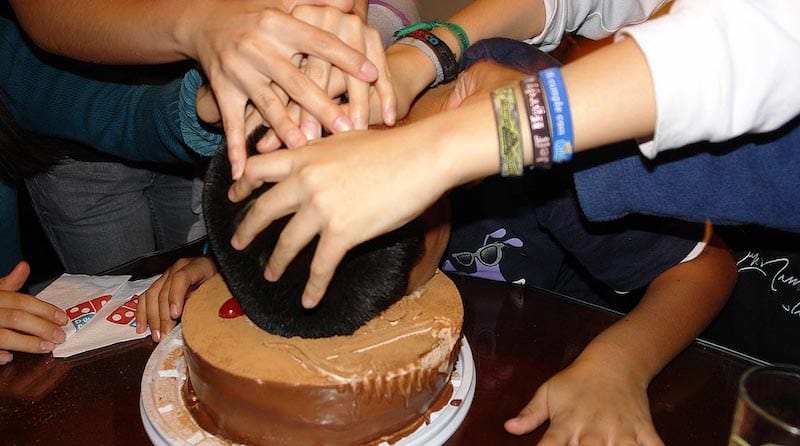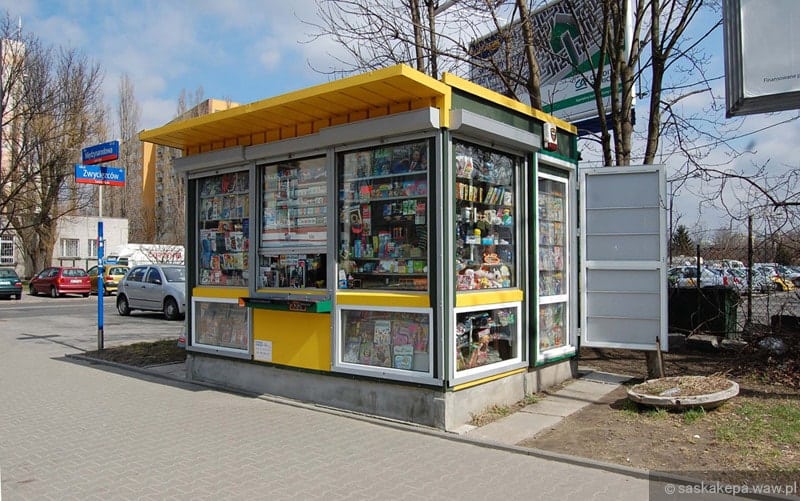Back when I was living in Mexico City, some of my cousins had in their school several foreign students. Sometimes they invited them over to have dinner, to birthday parties, or to play football with us. In one of those birthday parties we invited one of those foreigners to join us, he was from Germany.
At the party we had a cake with candles, and we started signing ‘Las Mañanitas’ (Mexican version of Happy Birthday song). When the song was over, my cousin blew the candles, and then something happened that the foreigner couldn’t believe it…
… All of my family started to sing ‘Mordida, Mordida, Mordida…‘ (in English: bite, bite, bite). The German guy didn’t know what was happening, so he just waited patiently. The rest of my cousins started gathering around the birthday boy, and suddenly we all pushed his head really hard and stuck his face into the cake.
The foreigner looked really confused and he was wondering what was wrong with us.
We explained to him that what he had just witnessed was a Mexican tradition called ‘Mordida‘, and we do it when someone is celebrating their birthday.

Before that birthday party, I was convinced that this celebration was common around the world, but after seeing the face of the German student I realized that this was not the case.
Some other things that I realised that are normal only to Mexicans are:
- We have different names for dishes that have exactly the same ingredients, but are prepared in a different way: quesadilla, flauta, chalupa, enchiladas, etc. For any foreigner, they look and taste the same
- Always denying the sauce is spicy
- Adding lemon and spicy sauce to most of our food, candies, fruit, etc.
- Arriving late is extremely normal
- You can hang bags of water from the ceiling to make flies go away
- We can fit 10 people in a Volkswagen Beetle
- Random people sell CD’s, candies, ice-cream, phone chargers, etc. inside the metro wagons
- 99.99% of the time when we eat, there will always be tortillas on the table
Travelling Abroad Changes Your Perspective
Traveling abroad is something that really opens your mind, and you start realizing that what you consider to be ‘normal’ in your hometown, might be extremely weird for the rest of the world.
For example, the first time I went abroad was in 2012, when I studied in Paris. I was completely clueless about other cultures and foreign traditions. So it was common for me to make ‘mistakes’ in my daily life like kissing on the cheek women I just met, which is something completely normal in Mexico. Or arriving two hours late to any party I was invited to.
Those situations happened a lot to me, but I realized that I was not the only one. People from different countries were making their own cultural mistakes as well.
Visiting new countries taught me great things about the cultures of people from other parts of the world.
Weirdest Things in Poland for a Foreigner
When I moved to Poland back in 2013, there were some things that were shocking for me (apart from the obvious like the cold winter or the difficulty of the Polish language), but that for a normal Pole were extremely normal.
Just like my ‘Mexican anomalies’ I described above, I decided to share with you the weirdest things in Poland for a foreigner (or in my case – a Mexican):
1. Weird Symbols in the Toilet
This the first thing I want to start with, as it was the one that caused me most problems in my first days in Poland.
In all the countries I’ve been to (there are not that many though), it was extremely easy to identify which toilet I needed to go to in case of an emergency.
For example, if you are a man you know that you need to look for the sign of a man standing (or sometimes the man is peeing), and if you are a woman you will look for the sign that shows the silhouette of a woman… But in Poland, this is COMPLETELY different.
In Poland they use a circle and a triangle to differentiate the right toilets for men and women! Yes, I’m not lying to you.

If you will visit Poland soon here is the best advice you will have for your trip:
- A triangle is the Men’s Room
- A circle is the Ladies’ Room
But why do Poles decide to use these? I have no idea! I’ve been trying to look for the answer to this, but so far I don’t have a clue. If someone reading this knows the answer please write it in the comments section.
What I think, the reason of these symbols is that Poles want to be unique just like with their Polish language.
By the way, if you are in a restaurant and you want to ask in Polish “Excuse me, where is the toilet?”, you need to say: “Przepraszam, gdzie jest toaleta?”
2. Taking Your Shoes Off When Entering a House
This might be normal in some other countries as well, but in Poland it was the first time that I experienced this.
In Poland, when you enter a house or a flat you need to take off your shoes, which was something completely crazy for me as in Mexico we wear shoes all the time, no matter if we are in the kitchen or on our sofa.
For me, this was something shocking and sometimes uncomfortable. Imagine you were just walking around the city on a hot day, so if you needed to take your shoes off in someone’s house the smell of your feet would probably not be the best…
Sometimes, the hosts will offer you a pair of sandals (they are called klapki in Poland) so you can walk around freely the house, which is something crazy for me as well, as you might be using the sandals that some stranger was using in the past.

I’ve asked my Polish friends, and they told me that the reason of this is to avoid making a mess inside the house. They remove their shoes so the floor keeps clean.
If you will go to a Polish house, before leaving make sure your socks don’t have a hole.
3. The Kiosks in Poland are For Small People
First let’s start defining what a Kiosk is. A kiosk is small stand/store with an open window on one side where you can buy newspapers, magazines, phone cards, cigarettes, tram tickets, toys and many other things.
The reason I’m saying that kiosks are for small people is that the window where the vendor will give you the merchandise is at a low height (maybe 1.20 meters from the ground) to avoid seeing his/her face.
If you want to buy something, or to see the vendor, you will need to bend down a lot! Thanks god I’m not that tall so I don’t have to kneel on the ground to know that’s going on down there.

These kiosks are weird for me, as in Mexico we are used to see the face of the person that is selling us something.
These kiosks are still extremely popular in Poland, and in most of them you can only pay by cash, so be aware of this in case you need a tram ticket for example.
4. Poles Love Open Sandwiches
Mexicans are really influenced by the American culture in some aspects, and one of these is how we eat sandwiches. The typical sandwich is a two-piece square bread with something in the middle, the only rule is that to make it a sandwich you must have at least two pieces of bread, one on the bottom and one on the top.
But in Poland, this is not the case. Poles have an obsession with open sandwiches! In Polish a sandwich is called kanapka (Kanapki in plural). And the main characteristic of these is that they will have only one piece of bread at the bottom. On the bread people normally put cheese, butter, ham, sausage, pickles, and so on. These also can make them sweet by putting butter, cheese, and jam.

Poles eat these homemade kanapki for breakfast or dinner, but if you are in a hurry you can buy a bigger open sandwich called Zapiekanka (Zapiekanki in plural) which might be considered the Polish pizza.
A zapiekanka is a half baguette (30 cm or more!) toasted with a range of toppings like mushrooms, salami, cheese, and basically anything you want. There are many places in Poland that sell these open sandwiches, and they are quite affordable. If you are walking around Poland you have to try one!

5. Adidas Shoes Have a Monopoly in Poland
Unless you are living under a rock, for sure you know the famous sports brand Adidas. They are well-known all over the world, but in internet (memes) Adidas has a special meaning in Central and Eastern Europe).
In Poland this is no different, and so all of the sports shoes/sneakers (no matter which brand) are called ‘Adidasy‘. It doesn’t matter if you are wearing clearly a pair of Nike shoes, Poles will refer them as Adidasy all the time! What free publicity this brand is receiving in Poland!
The reason for this is because in the past, Adidas was the top seller brand in the country, and slowly it became part of the culture – that’s why Poles will always refer to this.
But one important thing, if you want to refer to the shoes of the brand Converse, Poles call them ‘Trampki‘ – it’s the only exception in this Adidasy Empire.

In case you want to know, in Mexico we have similar things like this: we always say ‘Kleenex‘ to refer to a tissue, or ‘Pritt‘ to refer to any glue stick bar.
6. The Polish Lektor
This is the most annoying thing on this list for me, the Polish lektor.
The lektor is also known as voice-over or dubbed-over and and it is a form of audiovisual translation.
But the typical Polish lektor is like this: In 90% of the films I’ve watched on Polish TV, there is always the same voice of a male, around 50 years old, with absolutely no emotions. It doesn’t matter if there is a guy, a woman, or a child speaking, or if it’s an action, romantic, horror, or comedy movie, the tone and the voice of the lektor will always be the same.
I’ve always complained about this and I will always do, because all of the foreigners I know hate it. Don’t believe me? Ask your foreign friend to watch any movie with the lektor.

However, Poles seem to love this, they prefer this kind of translations rather than full-dubbing. Those lektors are well-known in the country and it’s a respected profession.
To be honest I don’t like full-dubbing either, but at least if a woman in the movie is talking, the voice that you will hear is of a woman not of a random guy with no emotions.
My top choice will always be the original language and just subtitles, the lektor is something that I will never get used to it.
Curious fact: One day I realized that the dad of one of my Polish friends, is one of the most popular Lektors in Poland. Maybe one day I will interview him if he doesn’t want to kill me after my review of his profession.
7. Birthday and Name Day
Life before Facebook was hard, I mean you had to remember all of the birthdays of your family members and friends, but thanks to Facebook you can remember them easily.
In Poland it seems that it was not enough for people to remember all the birthday dates, people also celebrate the Name Days! Don’t tell my Polish wife but I have no idea when her name’s day is.
This might not be that common anymore among young people, but for the past generations this is a huge deal! People organize parties or reunions to celebrate the name’s days and watch out if you forget the name’s day of your Polish mother in law, you will have a problem.
So please remember to ask for the birthday and name’s day of the Pole you just met. Remember to send them a message on both days. (I hope Facebook would introduce this date as well, it could save lives).
One more curious thing I noticed regarding this topic, in Polish language there is not a “Happy Birthday” phrase per se. In Poland you will say “Wszystkiego Najlepszego” which translates to “All the best“, or you can say “Sto Lat” which translated to “One Hundred Years“, but there is no “Happy Birthday” phrase. Interesting, isn’t it?
8. Polish Last Names Change Depending on the Sex
At the beginning of the post I was saying that something that was obvious to be expected to be different in Poland was the language. But I want to focus on something specific here.
Apart from all those crazy words to pronounce, and all those seven grammatical cases in Poland that make the life of a foreigner in Poland more difficult, it’s something that is absolutely crazy for me: Polish Last Names change depending on the sex of the person.
If you are not following me here let me explain you: In Mexico for example we always have two last names (first last name of the father and first last name of the mother). These last names never change at all. So if your last name is Perez, you and your sons and daughters will be Perez as well forever and ever.
In Poland this is different, first, it’s only common to have one last name (the one from the father), and the ending of this last name changes depending on the sex of the person. For example, if a person called Paweł Kowalski has a daughter named Anna, her last name will not be Kowalski as her father, her last name will change to Kowalska. This is something crazy for me and I will explain to you why.

As I said in Mexico the last names never change, so this means that if Paweł Kowalski travels with his daughter Anna to Mexico, and if someone checked their documents, the Mexican authority might imply that Kowalski is not the same as Kowalska, which mean that they are not relatives at all.
Maybe in some other countries this situation is the same, but it’s unreal for me that last names changes just like that. Crazy Polish language.
9. Customer Service Is … Not That Good
This is one of the top complaints and shocking experiences that I hear from my foreign friends, especially from Mexico or the USA.
I’m not really a bad or ungrateful customer as I worked in a few coffee places and in a call center in the past, so I know that sometimes customers are just annoying, but I’m being completely honest here and let me tell you that in Poland, the customer service is not that good.
As I mentioned before, Mexico is influenced in many aspects by American culture, and one of these is the quality of the customer service. If you have ever had a chance to visit Mexico, you could have noticed that sometimes the staff is way too friendly! Which might be creepy and annoying for some people.
If you are in a restaurant in Mexico, the waiters will come regularly and ask you if everything is good or if you need anything else. In Poland, well, you need to look and wait for the waiter to come to ask for something additional to your order (if he/she comes at all). Or for example, if you are in a clothing store in Mexico, as soon as you enter the staff will try to help you, this is really annoying sometimes but it’s helpful in case you need something. In Poland, it seems that there is no staff at all in case you want something in your size.
This is something that Poles don’t really notice, otherwise this would be different by now. Poles just learned how to deal with this.
I believe one of the main reasons for this is that in Poland is not mandatory to leave a tip, so customer service workers don’t really put the extra mile. In Mexico or the USA it is almost mandatory to give a tip no matter where you are, that’s why the staff might act differently. No smile no tip.
10. Poles Love Fermented Food
This is something that was weird for me but that I’m starting to like – Fermented Food.
This might sound a little bit gross in case you never visited Poland, but Poles have a particular way to prepare some food. Poles really like to prepare their own dishes at home, it’s really common that they prepare homemade ham, sausages, jam, and even vodka.
But also they prepare a lot of stuff that is fermented, for example the famous Polish ogórki (pickles). Poles love to ferment those pickles and spice them up. The result of this is delicious pickles called ogórki kiszone.

Poles also ferment cabbage! This is one of the most traditional Polish dishes called Kapusta Kiszona.
Also, around September Poles love to go to the forest and pick wild mushrooms (before coming to Poland I had never heard of this). They even have a word for this activity, it’s called Grzybobranie. After they picked those wild mushrooms, they prepare them in many ways, one of them is fermented mushrooms which in Polish is called grzyby kiszone.
Some Other Things That Might be Weird for Foreigners
Finally, there are some other weird things that I heard from my foreign friends living in Poland but for me are normal (we have this in Mexico too), which are:
- Pizza with ketchup: in Poland Poles eat pizza with ketchup, tomato sauce or garlic sauce. In Mexico we eat it with ketchup and obviously with spicy sauce.
- Pay to enter a toilet: in Poland (not in malls or restaurants), you will need to pay a fee to enter a public toilet, you have to pay from 2 to 5 PLN (0.40 to 1 Euro). In Mexico this is normal as well.
- Religion is important: in Poland many people are religious, and it had a boom when Karol Józef Wojtyła became Pope (Pope John Paul II). In Mexico it’s really common that people are religious as well.
And this my friends was the list of the weirdest things in Poland for a foreigner. If you are a Pole or a foreigner living in Poland: Do you think something is missing on this list? Share your comments below!







26 Comments
Really insightful & funny article!
As a Polish person living in Toronto, Canada i enjoyed your perspective.
Btw the open sandwich….is a common conversation between me & my Italian/Canadian boyfriend. He always argues that open sandwich is not a sandwich & he is insisting on the 2 piece of bread! And of course for me a proper, tasty sandwich is open faced;-) Cheers
Hi Beata! I had the same conversation with my Polish girlfriend haha for me an open sandwich it was not a proper sandwich, but now after a few years of living in Poland I just get used to it.
A big hug from Warsaw to Toronto!
Fascinating observations! Well written!
Thank you Robert! :)
The toilet symbols explanations that I found are:
1) circle – curvy or pregnant woman; triangle – resembles a shape of standing man – wide shoulders and narrow bottom;
2) these are the shapes of their reproductive organs;
3) they come from ♂️- in astronomy; it used to signify the planet of Mars, (God of War/Planet of Men) – simplified to only a triangle and ♀️ – it used to signify the planet of Venus; Roman (Goddess of love/Planet of Women) – reduced to only the circle.
Cheers!
Oh woow! Thanks Aneta! That’s the most complete answer I’ve read :D Thank you! This might be the reason! If you don’t mind, I will add it to the post (with proper credit of course)